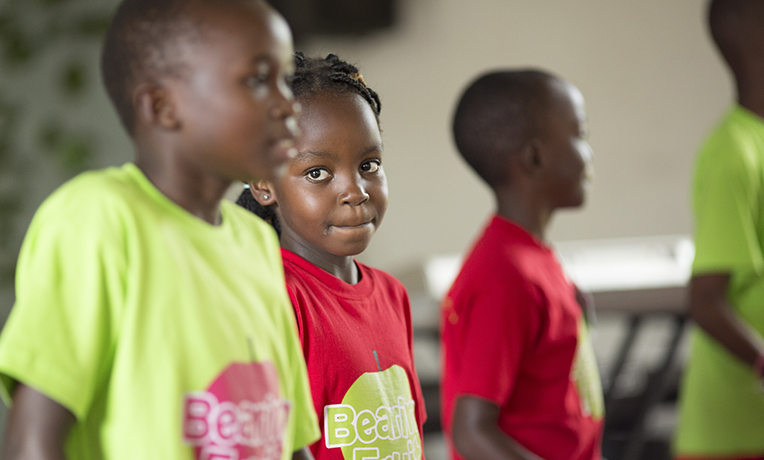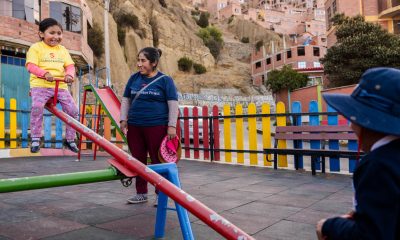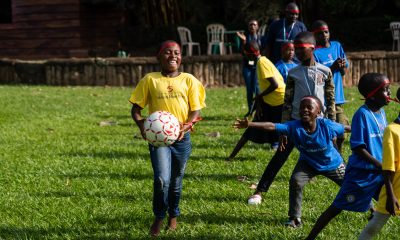Former Children’s Heart Project patients come together for a week of celebration and discipleship
In the U.S., congenital heart defects are the most common birth defect, affecting around 1 percent of all babies. They usually are treated within the first year of life, and these children go on to live a full, healthy life.

Before surgery, most children with heart defects can¹t run or play. At Heart Camp, these children have the opportunity to play with their friends and be normal children.
But in underdeveloped parts of the world, a heart defect is usually equal to a death sentence.
Babies in developing countries aren’t tested for heart defects before leaving the hospital. The burden falls on their mothers to recognize that their children aren’t growing and eating well. The mothers must then find a way to the hospital, which can be difficult for people who live in rural areas.
Once the mothers reach a hospital that can tell them what’s wrong with their babies, the situation seems hopeless. Often, there’s nowhere in the country that can perform the surgery. And if there is, it’s much too expensive for families struggling just to make ends meet.
“Kids don’t live long with these diseases,” said Dr. Joel Vanderford, the medical technical advisor for Children’s Heart Project in Uganda. “They don’t live well, they don’t live happy, they don’t live healthy.”
Children in Bolivia, Honduras, Mongolia, and Uganda have the chance to be screened by doctors who will refer them to Children’s Heart Project, the Samaritan’s Purse project that arranges life-saving operations for hundreds of children who live in countries where the required medical expertise and equipment are not available.

Aminah is now 21 years old and in college. She is able to live on her own. Before her heart surgery, she was 11 years old and didn¹t even weigh 40 pounds. Her mother had to carry her on her back. While living with her host family in the U.S., Aminah accepted Christ. She now shares His love with the younger campers.
“If you have money, if you’re well-to-do, you don’t come through Children’s Heart, so only those who don’t have any hope come through the program,” Dr. Vanderford said.
The project puts the children on a waiting list until a hospital in North America accepts the cases. While waiting, the strain on the families can feel unbearable. Many have to sell their belongings to pay medical bills, sometimes including their house. Their children are often hospitalized and sometimes can’t attend school. The children see that they are different and aren’t accepted, and sometimes the mothers blame themselves.
“My life was bad,” said 23-year-old Roger Birungi, who had surgery through Children’s Heart Project when he was 17. “Headache was terrible. My hair was bald. My chest was swollen. I wanted to fit in society. It was very hard. I felt in my heart that I’m going to die.”
Other children said that they couldn’t eat or walk before surgery. They felt sad, excluded, and shameful that their parents had to suffer on their behalf. Without the surgery, they would either still be suffering greatly, or they would be dead.

Dr. Joel Vanderford continues to check the children even after their surgeries to make sure they are healing properly. The check-ups also give the Children¹s Heart Project staff and chance to share the Gospel with the child¹s family and surrounding community.
“For the older children, I don’t think we would even see [them],” said Anna Thakkar, the Children’s Heart Project medical officer. “They would be dead. The conditions here in Uganda—you’ll find a family has poor nutrition, poor sanitation, and all that coupled with a sick heart, they wouldn’t be able to survive.”
Physical Changes and Spiritual Changes
Samaritan’s Purse is changing the lives of children in these situations. After a child is selected by a hospital in North America, they are flown to live with a Christian host family for six weeks before, during, and after the surgery. The surgery drastically and immediately changes the lives of the children.
“Now I can do everything I want,” Roger said. “I’m no longer worried of dying. I was not expecting to reach this age that I’m at now. Now I can fit in society.”
Having surgery helps children have good self-esteem, and for many, it provides an opportunity to attend school. Before surgery, many children are so sick that they can’t walk to school or pay attention in class.
The biggest change often is the spiritual change in their lives. Before the surgery, many of the children are not believers. Living with a Christian family for six weeks, having a Christian interpreter, and seeing the love of a Christian community poured out often changes their lives.

On the last day of camp, the campers¹ parents came to visit. The children performed for their parents on stage to show them what they had learned during the week.
“I was not saved, but now I’m saved,” Roger said. “Now I know God. I thank God for what I am now.”
Although the children’s repaired hearts will give them the life they want to live, only a spiritual change in heart can give them a connection with God.
“The point of it all is to not just change the physical heart but to work on the spiritual heart,” Dr. Vanderford said. “To be able to share with them that out of all the children that have congenital heart disease, the Lord chose you to have the opportunity to be healed. What are you now going to be with that? You’ve been chosen.”
Many of the children realize that God has a purpose in their lives and want to fulfill that purpose by worshipping Him, ministering to those around them, and changing their countries.
A Place for Learning and Freedom

Nine-year-old Miriam is an experienced camper. She has attended Heart Camp multiple times since it started in 2012 and has made friends who can relate to her.
Although many of the heart patients and their parents heard or even accepted the Gospel while in North America, the real work begins once they get home and try to get plugged into a community.
In Honduras, Mongolia, and Uganda, Children’s Heart Project is now offering Heart Camps to teach former patients how to fulfill God’s purpose for their lives.
As the children learn about God and how to share the Good News with others, it changes them. This is the third year of Heart Camp in Uganda, and Thakkar has seen each individual child become stronger both physically and spiritually.
“It has helped them a lot,” she said. “For one, I have seen that the children are much more outgoing. They’re friendly, they’re sociable, they’re so warm. Their self-esteem has grown over the years because they feel loved and appreciated, but most of all because they are getting to know more and more about God. It’s amazing to see how far they have come. It’s very evident that God is doing something in their lives.”
The camp provides a place for the children to learn about God, but it also helps them grow in their lives. The children often haven’t been able to

Nine-year-old Christine was attending Heart Camp for the first time. She enjoyed learning and spending time with the other children her age.
develop like their peers, so they are behind. Camp helps them catch up.
“When a kid is so sick for so long, you coddle them, you don’t let them do certain things,” Dr. Vanderford said. “It’s hard to then transition to we’re now healed and everything is OK. So being able to come away from the parents allows them to be free and to do whatever they really want to do.”
It also gives the children a place to bond with other people who understand them. Even children who have grown up and become well adjusted, like 21-year-old Aminah Naluyinde who is now a college student, need friendships with people who have been through similar experiences.
“You get to talk to other people,” she said. “You can share what you’ve been through, how it has been. You get to know more about each other.”
Counselors Who Can Relate

Many of the camp counselors can relate to the children because of the struggles they have had in their lives. One day, former heart patients may have the opportunity to counsel younger children as they attend camp.
In Uganda, the children have counselors at Heart Camp who they call aunties and uncles to help them relate to one another and to learn.
“The goal of camp is to introduce the Gospel,” Dr. Vanderford said. “To those that already know the Lord, to grow in their walk and then to connect them to an auntie or uncle who will continue to follow up with them throughout the year and disciple them.”
Several of the aunties and uncles in Uganda come from a place called Watoto Child Care Ministries. The home takes in children who are orphans or whose parents can’t care for them. Many of the children come from difficult backgrounds where parents were killed by war or disease. Although their situations are different from heart patients, they can often relate.

The small group sessions provide the children with an opportunity to interact with the lessons. This group of 8-9-year-old girls is especially excited to talk about the fruits of the Spirit.
“I believe we all have a unique story to tell in our lives,” said Nathan Kusasira, a Heart Camp uncle and former Watoto child. “For them, it’s in the form of health. They were on the verge of dying because they had a weak heart, but now they were repaired and they’re doing well. They were given a second chance. And it’s no different from my story. My father passed on when I was 7, left with a single mother. There were five of us. She couldn’t take care of all of us. Mom couldn’t raise the money for me to go to school. But when I entered into Watoto, I was given a second chance to live.”
The aunties and uncles tell their stories to the children and explain that they wouldn’t be where they are without God’s grace. They follow up with the children and set an example for them.
“When I see them, I [want] to be like them,” Roger said.
Changing the Community
When the children leave the camp, they are full of God’s love and new knowledge. To keep the excitement part of their everyday lives, they are encouraged to share what they have learned with their families. Some of the parents are Christians, and some became Christians during the process of their children’s surgeries. But many of them are Muslim or

Small group discussions give each child the chance to learn about Christ and to read directly from the Bible in his or her native language.
still practice traditional African religions.
“The Heart Camp is especially for the child, but we also know that when this child is deeply rooted in the Word of God, then they’re able to reach to their family,” Thakkar said.
The camp counselors and staff also support the children in getting involved in a local church where they live. They encourage them to serve and reach out to the local community.
“You now, through a child, have an open door to not only reach their family but the broader community,” Dr. Vanderford said. “It is Africa. There’s still a good bit of tribalism. So to reach that community that has been ignored, that has been persecuted for so many years, and now to give them hope, and the hope is in the Lord, it is amazing.”
Heart Camps are still new, with the first one held in Mongolia in 2011, but the effects of the camps can already be seen in the children’s lives.
Children who once couldn’t walk 100 feet can now win races. Children who were afraid to speak are now sharing their testimonies in front of their peers. They are telling their friends about the joy they have, and one day, they will have even more opportunities to share about God’s work in their lives.
“I hope that they can be professionals for this country, that they’ll be doctors, teachers, nurses, even preachers, even pastors, even evangelists,” Thakkar said. “I hope that they can be disciples for Jesus.”
There will be a second heart camp in Uganda in August, along with three camps in Mongolia and one in Honduras. Please pray that the children who attend these camps will have an opportunity to grow in their faith and become disciples for Christ.

During camp, the children learn Bible lessons from skits, like this one that explains the fruits of the Spirit. After the large group session, children break into smaller groups based on age and the language they are most comfortable speaking.







